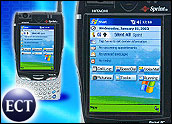
Sprint (NYSE: PCS) has unveiled a Windows Mobile-based PCS phone — developed by Hitachi — that touts the familiarity of the Microsoft Windows computing environment and the ability to communicate and connect to the Internet in a single, converged device.
The Hitachi G1000 combines the Pocket PC Phone Edition operating system with Sprint’s nationwide network and all the capabilities of a PCS phone. The company sees the device as an evolutionary step forward in converged devices, Sprint spokesperson Suzanne Lammers told TechNewsWorld.
However, Yankee Group analyst John Jackson said the US$650 price tag for the device limits its appeal to a small segment of the mobile market.
“These are not mass-market devices,” Jackson told TechNewsWorld. “They are really the province of early adopters.”
Hello on Handheld
The G1000 handheld – at 5.8 inches tall, 3.3 inches wide, 0.9 inches thick and 8.4 ounces – comes with an integrated rotating camera, built-in QWERTY keyboard and complete wireless phone. The device comes packaged with a USB cradle, AC adapter, travel charger and case with belt clip.
“This device is for the customer who wants to take the office with them, leave the laptop behind and be productive on a single device,” Lammers said.
Users of the converged device can conduct a telephone conversation by holding the handheld to their head, by using the built-in speakerphone or by using an earpiece that is sold separately.
A common criticism of converged devices is that they are more bulky than typical mobile phones, but Lammers said most users probably will make phone calls using an ear bud.
Task or Talk
Powered by the Intel XScale 400-MHz processor and touting 32 MB of memory, the G1000 comes with Windows Mobile software, including Pocket Excel, Pocket Outlook, Pocket Word, Windows Media Player, ActiveSync, Inbox and MSN Messenger.
On the phone side, the G1000 lets users connect to the PCS Network and includes a rotating VGA-quality digital camera, plus a Secure Digital (SD) expansion slot to let users expand the phone’s storage capabilities. Other features of the G1000 include voice-controlled dialing, an embedded GPS chip for future location-based services, and a replaceable lithium ion battery that provides 2.5 hours of talk time and a week of standby time.
Lammers said users can connect at up to 70 kilobits per second and can make calls or initiate data sessions to browse the Web or check e-mail, but cannot do both at the same time.
Converged Evolution
The G1000, which features a 65,000-color display, is the seventh such converged device from Sprint and represents the next evolutionary step for handhelds doubling as mobile phones, according to Lammers.
“These devices have become much faster, have higher processing power and offer improved screens,” she said.
The Yankee Group’s Jackson said the converged devices have come a long way from early attempts that were somewhat clumsy. “There have been some improvements in form factor and in function, but the demand for these devices remains unclear,” he said.
Losing to Laptops
Jackson said that because of operating system licensing, CDMA technology, larger memory and screen sizes, the price of converged devices remains prohibitively high.
In addition, the price of “air cards” – 802.11x, GPRS or other cards that enable wireless connectivity for laptops – has dropped below the $200 range, making them a more attractive option for mobile users, Jackson said.
“The persistently high prices [of converged devices], coupled with their relative immaturity, drives the emphasis for enterprise users toward laptops,” he said. “These are devices that are already installed; they have permeated the install space of the mobile professional.”





















































